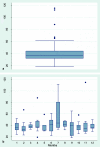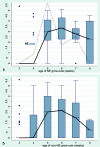The incidence of necrotic enteritis in turkeys is associated with farm, season and faecal Eimeria oocyst counts
- PMID: 34481490
- PMCID: PMC8418707
- DOI: 10.1186/s12917-021-03003-8
The incidence of necrotic enteritis in turkeys is associated with farm, season and faecal Eimeria oocyst counts
Abstract
Background: Specific studies on the epidemiology of necrotic enteritis in turkeys are absent in the literature. Necrotic enteritis is common in turkeys and a leading cause of use of therapeutic antibiotics. This study describes the incidence of necrotic enteritis in turkey farms, and the association between incidence and bird age, season, faecal oocyst counts, grow-out size and feed mill.
Results: Necrotic enteritis was diagnosed post mortem in 20.2 % of 545 grow-outs of commercial female and male B.U.T. 10 turkeys started during the years 2010-2016. 80 % of all cases occurred at four to seven weeks of age. Median (minimum-maximum) age at disease detection was 37 (18-115) days. Turkey age at detection was influenced by season, and varied from 33 days among grow-outs hatched in February to 42 days among those hatched in July-August. The incidence also varied with season, showing peak occurrence among grow-outs hatched during February-March and the lowest incidence in turkeys hatched in July-August. 59 % of all cases were detected in 25 % of the farms. The incidence per farm varied from below 4 to 59 %. A multilevel mixed-effects logistic regression model indicated clear impacts of farm and season on incidence, and border-line impacts of grow-out size and feed mill. Grow-outs diagnosed with necrotic enteritis had higher counts of faecal Eimeria oocysts than grow-outs without a diagnosis. This difference was particularly clear during the high-risk period at five to seven weeks of age. Necrotic enteritis was the cause of treatment with therapeutic antibiotics in 88.2 % of all cases of treatment.
Conclusions: Our data indicate that necrotic enteritis incidence in turkeys can be substantially influenced by risk factors at farm level. The incidence showed two seasonal peaks; a moderate peak in turkeys hatched in October/November and a marked peak in turkeys hatched during February/March. Mitigation measures at the farm may therefore be of particular importance during these months in farms located in the Northern temperate zone. Measures which effectively reduce counts of faecal Eimeria oocyst are likely to be among the more promising actions to take both at the farm and at population level.
Keywords: Age; Epidemiology; Feed mill; Grow-out size; OPG; Production performance.
© 2021. The Author(s).
Conflict of interest statement
The authors declare that they have no competing interests.
Figures



Similar articles
-
Developing an experimental necrotic enteritis model in turkeys - the impact of Clostridium perfringens, Eimeria meleagrimitis and host age on frequency of severe intestinal lesions.BMC Vet Res. 2020 Feb 18;16(1):63. doi: 10.1186/s12917-020-2270-5. BMC Vet Res. 2020. PMID: 32070340 Free PMC article.
-
Eimeria Oocyst Concentrations and Species Composition in Litter from Commercial Broiler Farms During Anticoccidial Drug or Live Eimeria Oocyst Vaccine Control Programs.Avian Dis. 2017 Jun;61(2):214-220. doi: 10.1637/11578-010317-Reg.1. Avian Dis. 2017. PMID: 28665719
-
Antimicrobials Used for the Therapy of Necrotic Enteritis and Coccidiosis in Broiler Chickens and Turkeys in Canada, Farm Surveillance Results (2013-2017).Avian Dis. 2019 Sep 1;63(3):433-445. doi: 10.1637/11971-091718-Reg.1. Avian Dis. 2019. PMID: 31967426
-
Prevalence of subclinical coccidiosis in broiler farms in Turkey.Trop Anim Health Prod. 2012 Mar;44(3):589-94. doi: 10.1007/s11250-011-9940-z. Epub 2011 Aug 4. Trop Anim Health Prod. 2012. PMID: 21814751
-
Non-Clostridium perfringens infectious agents producing necrotic enteritis-like lesions in poultry.Avian Pathol. 2016 Jun;45(3):326-33. doi: 10.1080/03079457.2016.1159282. Avian Pathol. 2016. PMID: 27009483 Review.
Cited by
-
The Optimization of Extraction Process, Antioxidant, Whitening and Antibacterial Effects of Fengdan Peony Flavonoids.Molecules. 2022 Jan 14;27(2):506. doi: 10.3390/molecules27020506. Molecules. 2022. PMID: 35056821 Free PMC article.
-
Stimbiotics help improve intestinal immunity and positively modulate the gut microbiome in broilers with necrotic enteritis.Poult Sci. 2025 Aug;104(8):105315. doi: 10.1016/j.psj.2025.105315. Epub 2025 May 17. Poult Sci. 2025. PMID: 40466265 Free PMC article.
-
Necrotic enteritis in a commercial turkey flock coinfected with hemorrhagic enteritis virus.J Vet Diagn Invest. 2023 May;35(3):317-321. doi: 10.1177/10406387231157711. Epub 2023 Feb 24. J Vet Diagn Invest. 2023. PMID: 36840379 Free PMC article.
-
Monensin phase-out in Norwegian turkey production decreases Bifidobacterium spp. abundance while enhancing microbial diversity.Microb Genom. 2025 Aug;11(8):001466. doi: 10.1099/mgen.0.001466. Microb Genom. 2025. PMID: 40833800 Free PMC article.
References
-
- Nicholds JF, McQuain C, Hofacre CL, Mathis GF, Fuller AL, Telg BE, Montoya AF, Williams SM, Berghaus RD, Jones MK. The effect of different species of Eimeria with Clostridium perfringens on performance parameters and induction of clinical necrotic enteritis in broiler chickens. Avian Dis. 2021;65:132–137. - PubMed
MeSH terms
Grants and funding
LinkOut - more resources
Full Text Sources

